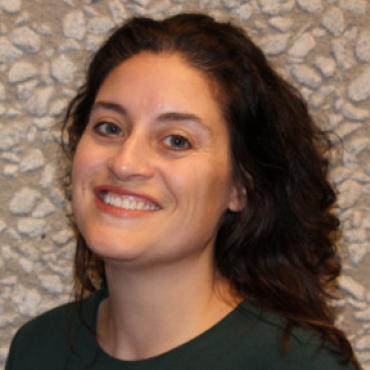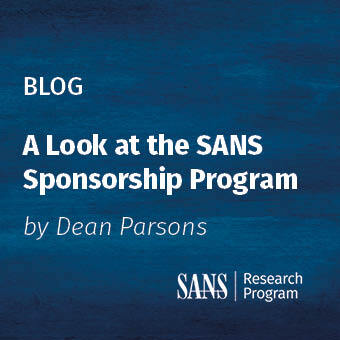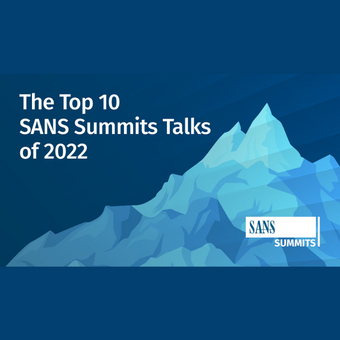Tags:
You want to increase your network and share your knowledge by speaking at a SANS Summit. We want Summit talks from a wide array of perspectives, topics, vertical industries, and experience levels. So we’re working towards the same goal – great talk proposals that get selected!
First, a little bit about how we solicit and select talks for Summit agendas: The process always starts with a Call for Presentations (CFP) in which we describe the event and present a (non-exhaustive) list of topics of interest developed by the Summit chairs, instructors, and advisory board.
Once all the submissions have been received, our advisory board does a two-phase review of the talks. In the first round of reviews, they see only the title and abstract of the proposed talk. We do this to eliminate any unconscious bias (positive or negative) based on knowing the identities of the submitters. In the second round, we reveal the names, titles, and organization of the prospective speakers and give the advisors a chance to modify their feedback based on that information – which they hardly ever do. What does that mean? It means your abstract needs to stand on its own. The board rates talks as yes, no, or maybe, and it’s pretty rare for a talk to convert from a maybe to a yes, so before you submit, you might want to take the advice of legendary bard Eminem: You only get one shot, do not miss your chance. Read on for tips on how to seize the moment.
Give us personalized attention.
If you decided to start the year by writing up one talk proposal and sending it out to as many conferences as you can find, you might want to re-think that strategy. The “spray and pray” approach might work for hooking newbies in your company’s monthly phishing assessment, but it’s rarely a successful way to get your talk proposal chosen. We can tell whether you’ve put thought into how your proposal is a fit for our event in particular. Read the CFP announcement carefully, check out videos from previous years’ Summits (almost always available on YouTube), dig into the presentation archives to see what talks have made it to the agenda in the past. Peek at recent blog or LinkedIn posts from the advisory board members to see what topics are top-of-mind for them. A little OSINT goals a long way.
What’s in a name?
Pop quiz: which talk title do you think is a winner?
a) Pepperoni, Pepperoncini, and Pineapple – Oh My!: An Overview of Pizza Toppings and the People Who Love Them
b) Ten Topping Tips: A Framework for Building Your Perfect Pizzaiolo-Approved Pie
c) Methodologies and Rationales for Evaluating and Selecting Vegetable, Cheese, and Meat Options for Optimizing Baked, Sauce-Topped Rounds of Dough
If you said B, give yourself a gold star! Yes, option A is fun, but you don’t need to be gimmicky to get noticed, and while it might have given us a giggle, we don’t really know what we’ll take away from the talk. Option C is obviously a little exaggerated, but don’t make us have to prop open our eyelids with toothpicks like a sleepy cartoon cat before we even get to your abstract, or chances are we’re just moving on to the next submission without reading.
Option B still brings a little fun in the form of alliteration, but also tells us what we’re going to get. We’re getting a framework; we love a framework! We’re getting tips – 10 of them! (We’re getting hungry, too, by the way!)
With all that said, don’t stress too much over the title. We have a whole marketing team who can add pizzazz if necessary. Err on the side of being clear and descriptive over cutesy or academic. Give us enough to make us want to read on.
Tell us everything.
Many probably-very-good Summit talks have failed to see the light of the stage (or Zoom) by getting stuck in “maybe” limbo, and it’s almost always because the abstract didn’t provide enough detail. A “maybe” rating from the board is the sad fate of talks that are topical, relevant, and possibly promising but get flagged with the comment, “Abstract doesn’t include much detail.” And the reality is, by the time we’re done with two rounds of reviews, we likely have enough talks in the “yes” pile that we never go back to the maybes to ask them to elaborate. When in doubt, tell us more. Don’t worry about the abstract being perfectly packaged for publication; focus on including concrete details about what the talk will include and how it will be constructed. Make it easy for us to select your talk by setting clear expectations and helping us see exactly how it fits into the agenda.
Here’s the sort of proposal that we’d really want to like but can’t give a green light to without knowing more:
Ten Topping Tips: A Framework for Building Your Perfect Pizzaiolo-Approved Pie
Topping the perfect pizza can be hard these days. There are just so many options and we all make so many decisions every day that by the time we’re ready to order, we’re fatigued and just default to whatever is easiest. We’ll share a framework based on extensive research to help combat lethargic pizza orders.
And here’s a sample proposal that really… delivers. (Sorry, we had to.)
Ten Topping Tips: A Framework for Building Your Perfect Pizzaiolo-Approved Pie
Abstract:
Nothing is more satisfying and life-affirming at the end of a long day than a perfect slice of pizza, hot from the oven and loaded with everything you love. But in 2019, a researcher at MIT found there are over 500 possible permutations just for a two-topping pizza†. How is a hangry, overworked pizza lover to choose? And how do we know we’re optimizing our pizza permutations, not just settling for the familiar? Our framework, developed in conjunction with Scuola di Alta Formazione Gastronomica in Naples, Italy, creates a decision tree based on factors including mood, weather, crust style, sauce, cheese, meats, vegetables, and beverage accompaniments. After attending this talk, attendees will be able to adapt the scalable Pizza Topping Framework to their own situation and have a working document they can refer to in order to build the most delicious pizzas and reduce decision fatigue.
Outline:
1. Overview of the framework
2. Factors affecting pizza optimization
a. Crust styles
i. Neapolitan
ii. New York
iii. “deep dish”
b. Cheese options
i. fresh mozzarella
ii. Mozzarella di bufala
iii. Ricotta
c. Meat options
i. prosciutto
ii. Sausage
iii. Pepperoni
Etc. (NB: You would NOT say “etc.” in your submission; we’re saying “etc.” here because you get the picture, and because we have to go order pizza now.)
So what?
It’s not just our pizza toppings we take seriously; we mean business when we talk about The SANS Promise. Every session we put on our agenda should teach our attendees something they can use as soon as they get back to work. Don’t leave us in suspense or assume that we’ll be able to figure out what that takeaway is. State it explicitly; for example: “After attending this talk, attendees will be able to adapt the scalable Pizza Topping Framework to their own situation and have a working document they can refer to in order to build the most delicious pizzas and reduce decision fatigue.”
Deadlines are not merely suggestions.
Our CFPs are generally open for three to eight weeks, depending on the timeline for a particular Summit. In any case, we promise we’ll never have a Flash CFP where you have 24 hours to turn in your submission. We know dramatic and unavoidable things come up – we’re in cybersecurity, too, after all. And we know that being human means having unexpected things happen that can disrupt the most carefully laid plans. But our CFP deadlines are clear, and they’re real. Our advisory board members are volunteers who are doing this in addition to their day jobs, so we create a timeline for reviewing submissions and we respect their time by sticking to that. They’re generally already starting the process the day after the deadline. When you send an email to petition for a post-deadline submission to be accepted, it makes extra work for the board members, and makes us wonder if you’ll also have trouble meeting the incremental deadlines along the way if your talk is selected. We’re real people, and we’re pretty nice, so in extraordinary circumstances, please do reach out, but if you just didn’t see the CFP until the day before it closed, getting a bunch of people to do a bunch of extra work to make an exception is a bit of a wrong-footed beginning. The good news is that this is easily avoided. Opt in to receive our CFP newsletter, and you’ll never miss a deadline again.
Still have questions? Email us at SummitSpeakers@sans.org.
†We made this up based on some sketchy results of a Google search.





